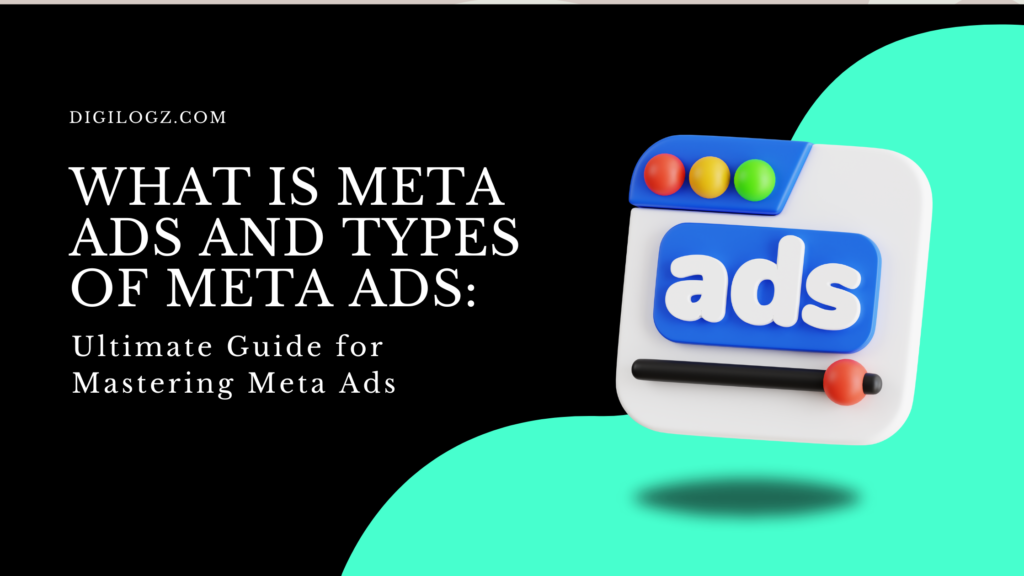What is Meta Ads and Types of Meta Ads: Ultimate Guide for Mastering Meta Ads
In the ever-evolving landscape of digital marketing, Meta ads have emerged as a powerful tool for businesses to reach and engage their target audience effectively.
Purpose of the Guide
This ultimate guide will delve into the world of Meta ads, providing you with a comprehensive understanding of what they are, their various types, and how you can leverage them to maximize your marketing efforts.
Overview of Meta Ads
Meta ads have a rich history, evolving from simple banner ads to sophisticated, highly targeted campaigns. Their significance in the digital marketing landscape cannot be overstated, as they offer unmatched precision and effectiveness.
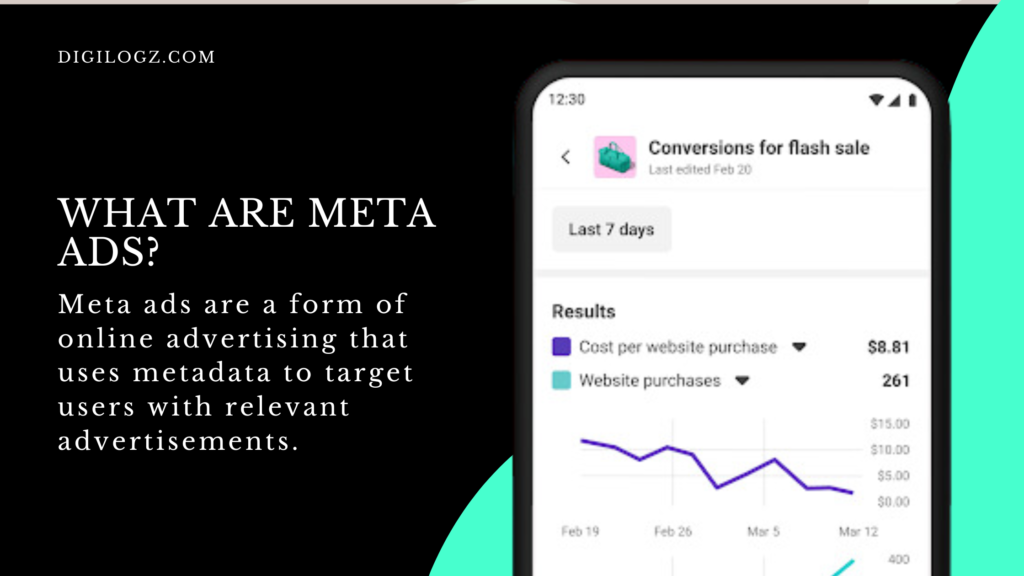
What are Meta Ads?
Definition of Meta Ads
Meta ads are a form of online advertising that uses metadata to target users with relevant advertisements. Unlike traditional ads, which are often broad and unspecific, Meta ads use detailed user information to deliver highly targeted content.
How Meta Ads Work
These ads operate on advanced algorithms and platforms, such as Google Ads and Facebook Ads, to serve advertisements that are most likely to resonate with the user. By analyzing user behavior, interests, and demographics, Meta ads ensure that the right message reaches the right audience at the right time.
Benefits of Meta Ads
Meta ads offer numerous advantages for businesses:
- Reach: Access to a vast audience across multiple platforms.
- Targeting: Precision targeting based on user data.
- ROI: High return on investment due to effective targeting and engagement.
Types of Meta Ads
1. Search Ads
Overview
Search ads appear on search engine results pages (SERPs) and target users based on their search queries. These ads are typically text-based and appear at the top or bottom of the SERP.
Benefits
Search ads are highly effective due to their relevance to user intent, resulting in higher conversion rates and targeted advertising.
Best Practices
To optimize search ads:
- Use relevant keywords.
- Write compelling ad copy.
- Continuously monitor and adjust bids.
2. Display Ads
Overview
Display ads are visual advertisements that appear on websites within a display network. They can be images, videos, or interactive ads.
Benefits
Display ads are great for building brand awareness, as they have a wide reach and can be visually appealing.
Best Practices
For effective display ads:
- Create visually appealing designs.
- Use clear call-to-actions.
- Target relevant audiences.
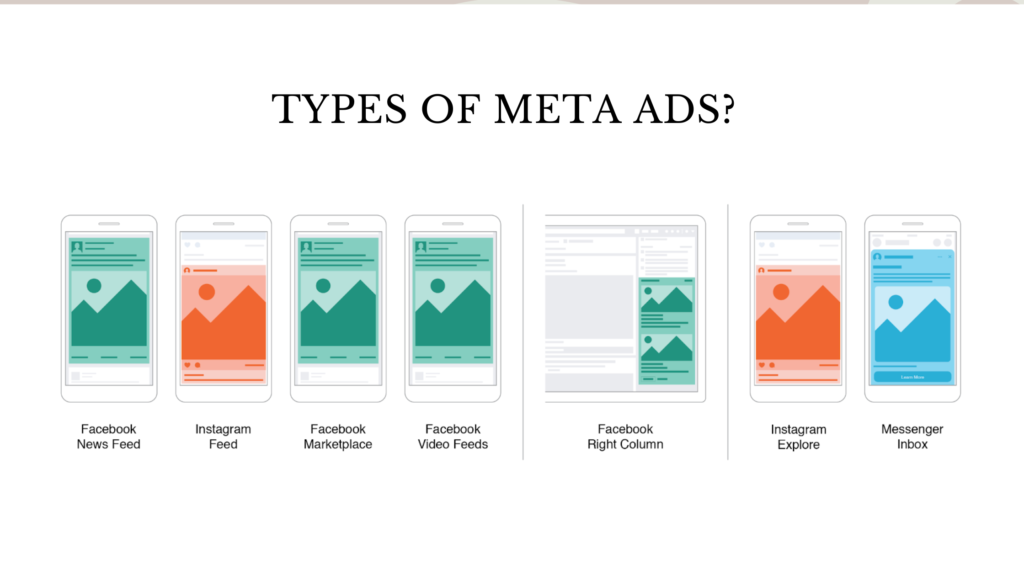
3. Social Media Ads
Overview
Social media ads leverage the unique features of platforms like Facebook, Instagram, and WhatsApp to engage users.
Benefits
These ads offer high engagement rates, precise targeting, and the ability to use social proof to enhance credibility.
Best Practices
Effective social media ads require:
- Engaging content.
- Platform-specific features.
- Active audience interaction.
a. Facebook Ads
Overview
Facebook ads come in various formats, including image, video, and carousel ads. They offer extensive targeting options based on user demographics, interests, and behaviors.
Benefits
Facebook ads provide detailed targeting options, access to a vast user base, and robust analytics to measure performance.
Best Practices
To optimize Facebook ads:
- Use engaging visuals and content.
- Utilize Facebook Pixel for tracking.
- Optimize ad placements.
b. Instagram Ads
Overview
Instagram ads focus on visual content, leveraging images and videos to tell compelling stories.
Benefits
These ads have high engagement rates, are visually appealing, and integrate seamlessly with Facebook’s ad platform.
Best Practices
For effective Instagram ads:
- Use high-quality visuals.
- Leverage Stories and Reels.
- Collaborate with influencers.
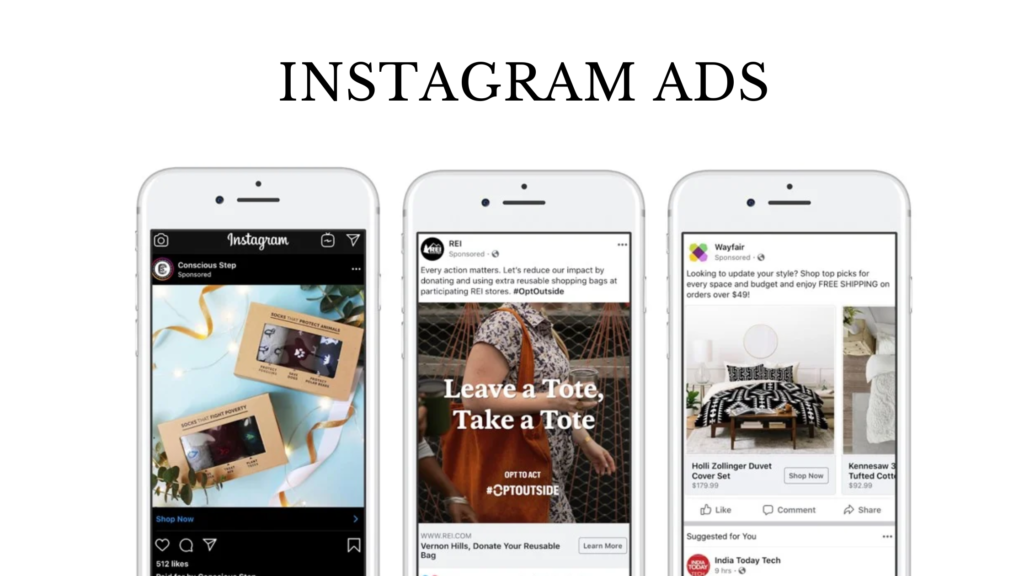
c. WhatsApp Ads
Overview
WhatsApp ads are used for conversational marketing, engaging users directly through the messaging app.
Benefits
WhatsApp ads allow for personalized communication, direct user engagement, and high open rates.
Best Practices
Effective WhatsApp ads should:
- Use clear and concise message templates.
- Integrate chatbots for automation.
- Ensure user privacy and data protection.

4. Video Ads
Overview
Video ads are gaining popularity due to their engaging format and storytelling potential. They can be used across various platforms like YouTube, Facebook, and Instagram.
Benefits
Video ads offer high engagement, effective storytelling, and compatibility across multiple platforms.
Best Practices
To create engaging video ads:
- Keep videos short and to the point.
- Use high-quality production.
- Optimize for different platforms.
5. Shopping Ads
Overview
Shopping ads promote products directly on search engines and e-commerce platforms, displaying product images, prices, and merchant information.
Benefits
These ads drive direct product promotion, have high visual appeal, and attract high purchase intent.
Best Practices
Effective shopping ads require:
- Optimized product listings.
- High-quality images.
- Targeting the right audience.
6. App Ads
Overview
App ads promote mobile applications, encouraging users to install and engage with the app.
Benefits
App ads drive direct installs, increase user engagement, and offer cross-promotion opportunities.
Best Practices
To optimize app ads:
- Design compelling ad creatives.
- Use effective targeting.
- Monitor performance metrics.
How to Create Effective Meta Ads
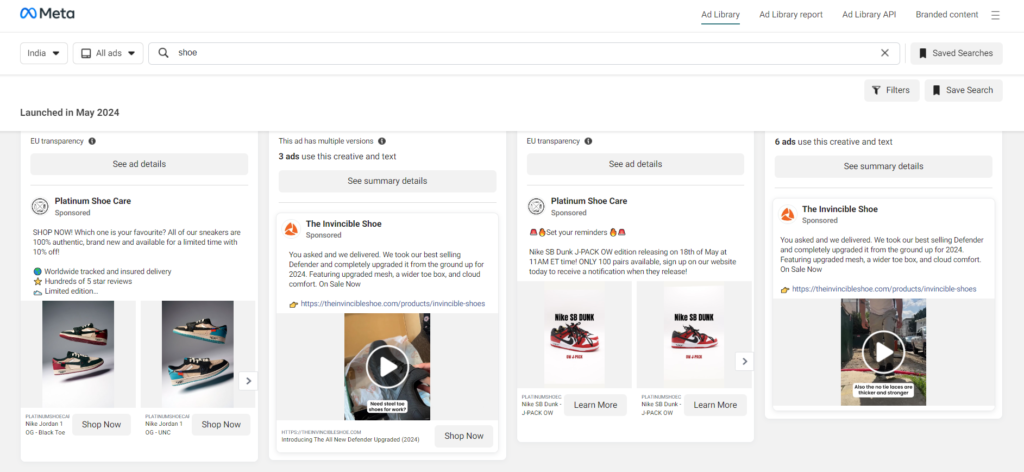
Creating effective Meta ads involves a combination of strategic audience targeting, compelling ad copywriting, engaging visual design, rigorous A/B testing, and diligent performance tracking. Here’s a detailed guide on how to master each of these components.
Audience Targeting
Understanding Your Audience: To create effective Meta ads, it’s crucial to understand and segment your target audience. Begin by analyzing detailed user data, including demographics, interests, behaviors, and past interactions with your brand. Use tools like Facebook Audience Insights and Google Analytics to gather this data.
Segmenting Your Audience: Segment your audience based on the gathered data. Create specific groups that share common characteristics, such as age, location, interests, and purchasing behavior. This allows you to tailor your ads to each segment’s unique preferences and needs.
Refining Targeting Strategies: Use advanced targeting options available on Meta platforms, such as custom audiences, lookalike audiences, and behavioral targeting. Custom audiences let you target users who have already interacted with your brand, while lookalike audiences help you reach new users similar to your best customers.
Example: If you run an online clothing store, you might segment your audience into groups such as “young professionals interested in fashion” and “mothers looking for children’s clothing.” This allows you to create specific ads that speak directly to each group’s needs and preferences.
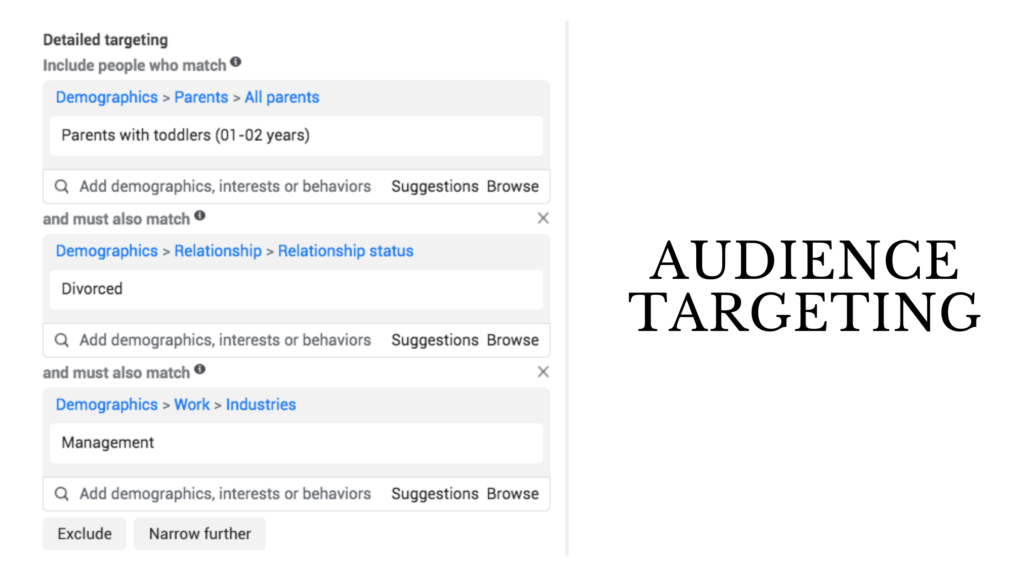
Ad Copywriting
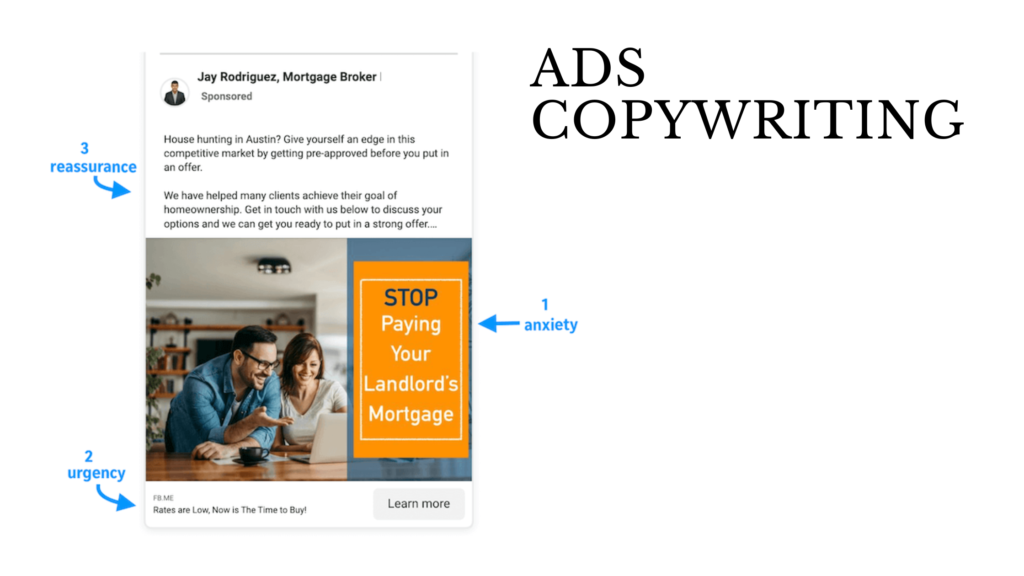
Crafting Compelling Ad Copy: Effective ad copy is concise, engaging, and tailored to your audience. Your message should resonate with your target audience and compel them to take action. Focus on the benefits of your product or service and how it solves a problem or meets a need.
Using Strong Calls to Action (CTAs): Include clear and persuasive CTAs that guide users towards the desired action, whether it’s making a purchase, signing up for a newsletter, or visiting your website. Phrases like “Shop Now,” “Learn More,” and “Sign Up Today” can be highly effective.
Incorporating Emotional Triggers: Use emotional triggers in your ad copy to create a connection with your audience. Highlighting pain points, aspirations, and desires can make your ad more relatable and compelling.
Example: For a fitness app, you might use copy like, “Transform your fitness journey with personalized workout plans. Download our app today and get started for free!”
Visual Design
Creating Eye-Catching Visuals: Visuals are a critical component of your Meta ads. Invest in high-quality images, videos, and graphics that align with your brand and message. Your visuals should be clear, professional, and attention-grabbing.
Aligning Visuals with Your Brand: Ensure that your visuals are consistent with your brand identity. Use your brand’s color palette, fonts, and style to create a cohesive look across all your ads.
Optimizing for Different Platforms: Design your visuals to be compatible with various platforms and formats. For instance, use vertical videos for Instagram Stories and Facebook Stories, and square images for Facebook and Instagram feeds.
Example: If you’re advertising a new product launch, create a short video highlighting the product’s features, benefits, and real-world use cases. Ensure the video is visually appealing and captures the viewer’s attention within the first few seconds.
A/B Testing
Implementing A/B Testing: A/B testing involves creating two or more versions of an ad to determine which performs better. Test different elements such as headlines, images, ad copy, and CTAs to see what resonates most with your audience.
Isolating Variables: To get clear and actionable insights, test one variable at a time. For example, if you’re testing headlines, keep the rest of the ad consistent.
Running Tests Over Time: Allow your tests to run for a sufficient period to gather meaningful data. Short testing periods might not provide enough data to make informed decisions. Typically, a two-week period is recommended.
Example: Run an A/B test with two different headlines: “Get Fit with Our New Workout App” versus “Transform Your Fitness Journey Today.” Compare the results to see which headline generates more clicks and conversions.
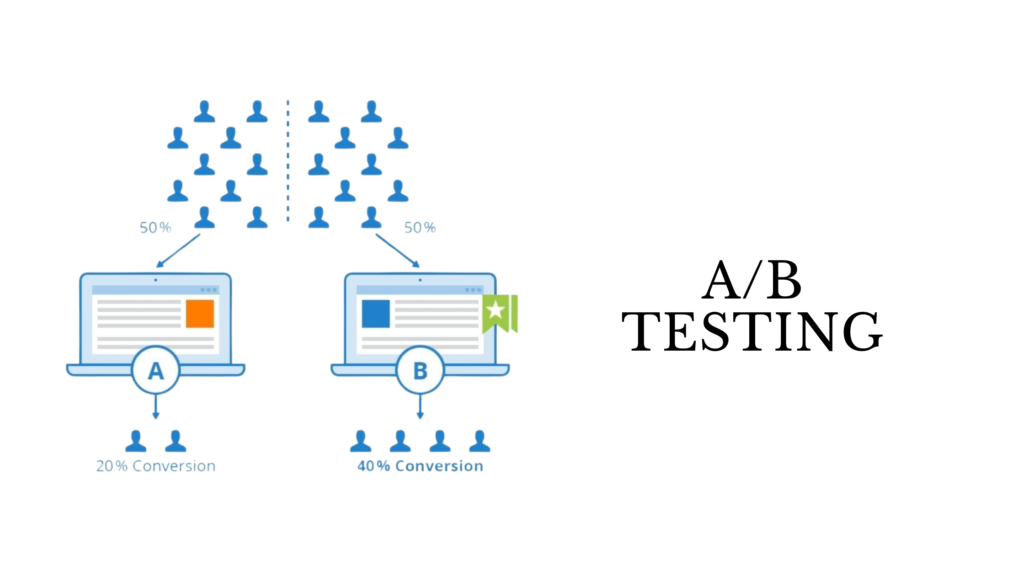
Performance Metrics
Tracking Key Metrics: Monitor key performance metrics to measure the success of your Meta ads. Important metrics include click-through rates (CTR), conversion rates, return on ad spend (ROAS), and cost per conversion.
Analyzing Data: Use analytics tools to analyze the performance data. Look for trends and patterns that can inform your future ad strategies. Identify which ads are performing well and which ones need improvement.
Making Data-Driven Decisions: Use the insights gained from your performance metrics to make data-driven decisions. Continuously refine and optimize your ad campaigns based on the data to improve results.
Example: If you notice that ads with video content have higher engagement rates compared to static images, you might decide to allocate more budget towards creating video ads.
By mastering these components, you can create highly effective Meta ads that drive engagement, conversions, and ROI. Continuously test, analyze, and refine your strategies to stay ahead in the competitive digital marketing landscape.
Case Studies and Success Stories
Case Study 1: Meta Ads Sales Campaign
Background: A prominent e-commerce company launched a Meta ads Sales campaign to boost online sales. Their goal was to target potential customers most likely to convert.
Strategies Used:
- Simplified Account Structure: The company streamlined their ad account structure, consolidating ads into fewer ad sets. This approach led to an 18% reduction in Cost Per Action (CPA).
- Broad Targeting: They employed broad targeting while excluding existing customers and retargeting audiences, reducing CPA by 12%.
- Mobile-Friendly Videos: Ads were optimized for mobile, using vertical videos and attention-grabbing content in the first three seconds, which resulted in a 12% lower cost per conversion.
- A/B Testing: Continuous A/B testing was conducted to identify the best-performing ad variations, resulting in a 30% decrease in the cost per result.
Results:
- Click-Through Rate (CTR): The campaign achieved a CTR of 1.30%.
- Conversion Rate (CR): The conversion rate was 89.5% higher compared to a previous traffic campaign.
- Return on Ad Spend (ROAS): The ROAS increased by 76%, demonstrating the campaign’s effectiveness in driving sales and optimizing budget usage.
Source: Lebesgue.io
Case Study 2: Range Rover Evoque Campaign
Background: Range Rover aimed to highlight the capabilities of their Evoque model with a video campaign that addressed a common driving problem.
Strategies Used:
- Emotional Connection: The campaign focused on a relatable driving issue, showcasing how the Evoque tackled it, which resonated with a broad audience.
- Seeding Strategy: Initial releases were targeted at key markets before the global launch, helping to build anticipation and momentum.
- Social Media Virality: The campaign was designed to be shared widely on social media platforms, leveraging its engaging content to increase reach.
Results:
- Views: The campaign video garnered over 100 million views.
- Engagement: It became viral on social media, significantly boosting brand awareness.
- Emotional Impact: The strategy of addressing a common problem and connecting emotionally with the audience proved highly effective.
Source: ItsFunDoingMarketing
Lessons Learned
From these case studies, several actionable insights can be drawn:
- Simplify Account Structures: Streamlining your ad account can significantly reduce costs and improve ROAS.
- Broad Targeting with Exclusions: Broad targeting, when combined with the exclusion of existing customers, can effectively reduce CPA and expand your reach.
- Optimize for Mobile: With a significant portion of users accessing content on mobile devices, optimizing ads for mobile is crucial.
- A/B Testing: Continuous testing of different ad elements can help identify the most effective strategies, reducing costs and improving overall campaign performance.
- Emotional and Relatable Content: Creating content that resonates emotionally with your audience can drive higher engagement and virality.
- Strategic Rollout: Initial seeding in key markets can build momentum and enhance the global impact of your campaign.
These strategies and insights can help you create more effective and efficient Meta ad campaigns, driving better results and maximizing your marketing efforts.
Common Mistakes to Avoid
Overgeneralization
Issue: Broad audience segments can dilute the effectiveness of your Meta ads, leading to lower engagement and conversions.
Solution: Focus on precise targeting to ensure your ads are relevant to the audience. Use detailed demographic and behavioral data to create targeted segments. This approach will help you reach individuals who are more likely to be interested in your products or services, enhancing ad relevance and performance.
Example: Instead of targeting “all adults aged 18-65,” narrow it down to “women aged 25-34 who have shown interest in fitness and wellness.”
Ignoring Analytics
Issue: Not regularly tracking and analyzing ad performance data can result in missed opportunities for optimization and wasted ad spend.
Solution: Regularly monitor key performance metrics such as click-through rates (CTR), conversion rates, and return on ad spend (ROAS). Use analytics tools to gather insights and make data-driven decisions to optimize your campaigns. Adjust your strategies based on performance data to improve results continuously.
Example: If you notice that certain ad creatives have higher engagement rates, allocate more budget to those creatives and experiment with similar content.
Neglecting Mobile Users
Issue: With a significant portion of users accessing content via mobile devices, neglecting mobile optimization can lead to poor user experience and lower engagement.
Solution: Ensure your ads are optimized for mobile devices. Use mobile-friendly formats such as vertical videos and responsive designs that look great on smaller screens. Prioritize fast loading times and easy navigation to enhance the mobile user experience.
Example: Design your video ads in a 9:16 aspect ratio and include compelling visuals and messages in the first few seconds to capture the attention of mobile users quickly.
Poor Ad Copy and Design
Issue: Lackluster ad content and visuals can fail to attract and retain attention, reducing the effectiveness of your ads.
Solution: Invest in high-quality ad copy and design. Craft compelling and concise ad copy that resonates with your audience. Use eye-catching visuals that align with your brand and convey your message effectively. Consistently test and refine your creatives to ensure they stand out and engage your target audience.
Example: Use vibrant colors, clear fonts, and strong call-to-actions in your display ads. Incorporate storytelling elements in your video ads to create an emotional connection with your audience.
By avoiding these common mistakes, you can significantly improve the performance and effectiveness of your Meta ad campaigns, ensuring better engagement, higher conversions, and a stronger return on investment.
Future Trends in Meta Ads
AI and Automation
Trend: Artificial intelligence (AI) and automation are revolutionizing Meta ads, making campaigns more efficient and effective.
Impact: AI-driven tools can analyze vast amounts of data to identify patterns and optimize ad performance in real-time. Automation streamlines campaign management by handling tasks such as bidding, ad placements, and audience targeting, allowing marketers to focus on strategy and creativity.
Example: AI can predict which ads are likely to perform best with specific audiences, automatically adjusting bids to maximize ROI. Automation tools can run A/B tests and analyze results to continuously improve ad effectiveness.
Personalization
Trend: Personalized ad experiences are increasingly important, driving higher engagement and conversion rates.
Impact: Personalized ads resonate more with users by addressing their specific needs and preferences. This tailored approach leads to better user experiences and increased likelihood of conversions.
Example: Dynamic ads on Facebook can show different products to users based on their browsing history and past interactions. Personalized email campaigns can deliver tailored content that aligns with user interests, improving open and click-through rates.
Cross-Channel Integration
Trend: Seamless integration across various digital channels is becoming more prevalent, enhancing the overall user experience and campaign effectiveness.
Impact: Cross-channel integration ensures that users have a consistent experience regardless of the platform they are on. It allows for cohesive storytelling and unified messaging across social media, search engines, email, and other digital channels.
Example: A campaign might use Facebook ads to drive initial awareness, retarget interested users with display ads on Google, and follow up with personalized email offers, creating a seamless journey from awareness to conversion.
Privacy and Data Protection
Trend: Emerging trends in data privacy are significantly impacting advertising strategies, emphasizing the importance of user consent and data protection.
Impact: Stricter data privacy regulations, such as GDPR and CCPA, require advertisers to be more transparent about data collection and usage. This shift is driving the adoption of privacy-first advertising practices and the use of first-party data.
Example: Companies are implementing cookie consent banners to obtain user permission for tracking. They are also investing in privacy-focused technologies and strategies, such as contextual targeting, which doesn’t rely on personal data but instead focuses on the context of the content being consumed.
By staying ahead of these trends, businesses can create more effective Meta ad campaigns that not only meet regulatory requirements but also deliver enhanced user experiences and improved performance.
Conclusion
Recap of Key Points
In this guide, we’ve explored the world of Meta ads, highlighting their definition, benefits, and various types including search ads, display ads, social media ads, video ads, shopping ads, and app ads. We’ve discussed the importance of precise targeting, effective ad copy, and visually appealing designs. By understanding these elements, businesses can leverage Meta ads to enhance their digital marketing efforts, achieve higher engagement, and drive conversions.
Encouragement to Start
Now that you have a comprehensive understanding of Meta ads and their potential, it’s time to put this knowledge into practice. Start experimenting with different types of Meta ads, utilize the best practices discussed, and continuously monitor and optimize your campaigns. By doing so, you’ll be well on your way to achieving your marketing goals and maximizing your return on investment.
Call to Action
For further assistance and deeper insights into mastering Meta ads, explore additional resources and services. Whether you need help with campaign setup, creative design, or advanced targeting strategies, there are plenty of tools and experts available to support your journey. Start your journey towards mastering Meta ads today and transform your digital marketing strategy.
A

